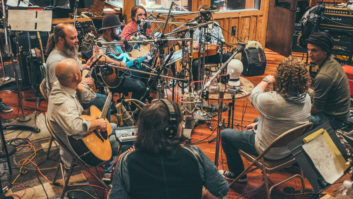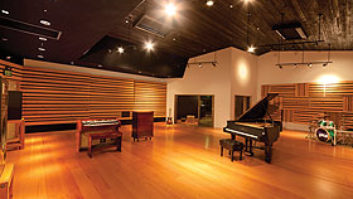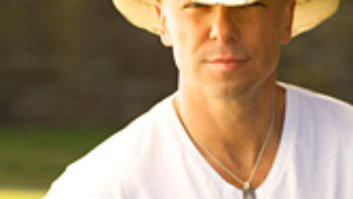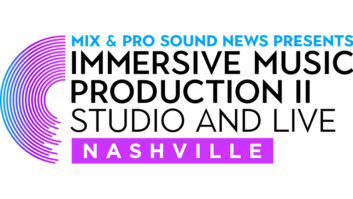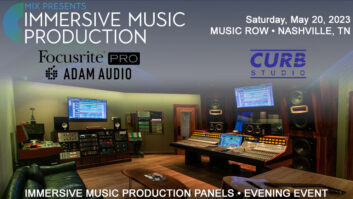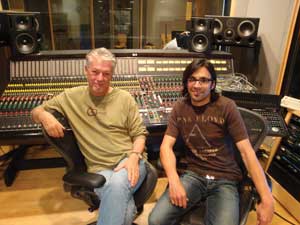
Brent Maher (left) with Charles Yingling in The Blue Room
Photo: Peter Cooper
Brent Maher sits in the control room of The Blue Room, his recording studio in Nashville’s Berry Hill neighborhood. Lots of folks were sitting in lots of Berry Hill control rooms that day, but only one of them could talk about his experience engineering Ike and Tina Turner’s version of “Proud Mary.”
“I did about two-and-a-half records with them,” Maher says. “I loved working with Ike and Tina. For all that must have been going on behind the scenes, none of that was ever brought into the studio. It was extreme high energy and a lot of fun. When Tina was recording, she just exploded into the microphone. It was as if she was performing for 10,000 people. I was big into Creedence Clearwater Revival back then, and I remember Ike told the band, ‘Let’s do “Proud Mary” next.’ I said, ‘You mean the Creedence “Proud Mary”?’ He said, ‘Yeah, but we do it a little bit different.’ Tina sang and that band broke loose and it was like a religious experience. I tell you, I felt the energy of it.”
At The Blue Room, which he purchased in October of 2008 after leasing for several years, Maher and chief engineer/mixer Charles Yingling are quite concerned with energy. The studio is designed for musicians to play together, in real time, in close enough proximity to allow for eye contact and body language, yet far enough away from each other to control undue sonic bleed.
“We have two isolation areas, and we have no problem with putting amps in halls and bathrooms,” Maher says. “We also have a Pro Tools room with its own vocal and recording area, and it’s tied in with everything else, so we can put singers there or horns there. When tied together, you can work as many as 10 people here, but 70 percent of what we do is between four to six players, and that’s comfortable. The outboard gear we have is very basic, but the console is very, very solid.”
The console in question is a Trident TSM, built in 1974. “Anything percussive that comes through the board is very punchy, and it’s got a cool little top end,” Maher says. “Charles has to keep Band-Aids on it to keep it up and going sometimes, but sonically it rocks. Between that and the updated converters in RADAR, there’s a lot of warmth and depth to what we record.”
Lately, Maher has produced Wynonna Judd’s Sing: Volume 1 at The Blue Room, and he and Yingling have recorded projects from Johnny Reid (a Platinum-selling country star in Canada who should soon make a mark in the U.S. market) and the inventive Americana artist Kieran Kane.
“On this last record, we captured almost half of Wynonna’s vocals live with the band,” Maher says. “She really torched them, and it inspired the band at a high level. Those guys would be trying to catch their breath. We just put a Neumann CMV563 on Wy the whole time and let it roll.”
Maher has known Judd since she was a teenager. He discovered The Judds in the 1980s, and his production work helped Naomi and Wynonna Judd become the most popular mother-daughter duo in music history. In doing that, he also helped elevate the acoustic guitar to a lead instrument in country music, a form that had been dominated by electric guitar solos since the 1950s.
“Fashioning The Judds’ sound came from working with the girls in their kitchen, with Wy playing acoustic guitar and me playing acoustic guitar and eventually [assistant producer] Don Potter on acoustic guitar,” Maher says. “That was so much a part of the magic. I thought, ‘How can I make a record that has no electric guitars but that will rock on the radio and catch people’s attention?’ But then I thought, ‘Well, Simon & Garfunkel’s “Mrs. Robinson” was one of the most aggressive records on radio and that was acoustic. And then there was the Everly Brothers. And Ricky Skaggs was doing some of that on country radio. It’s more about the arranging and keeping things out of the way, allowing room for a percussive acoustic guitar part to drive a record.”
Don Potter played the driving acoustics on Judds hits including “Why Not Me” and “Turn It Loose.” Maher used a variety of microphones on Potter’s acoustic, including a Neumann U67 and U87, and an AKG 414.
“They all sounded good, and it was probably better not to have the exact same sounds on every song,” Maher says.
Among the projects Maher is most excited about at the moment is Shel, an all-sister pop group from Colorado Springs that has already drawn attention from heavies including Eric Clapton. “They’re incredibly talented,” Maher says. “They have a little Pro Tools outfit at their house where they do basic tracks: mandolin, keyboard, electric bass, violin and vocals. They lay those down and ship them to me, and we do the other stuff here. It’s an interesting way to produce. We do things with [Internet video-phone service] Skype, and I’ve never done anything like that. If they record something that needs work, I can say, through Skype, ‘I think we can re-address this.’ Ten minutes later, they’ve re-recorded it and shot it back to us, and we fly it in and go to work. It’s a new way of making a record for me, and that’s what I live for.”
Send Nashville news to
[email protected].
